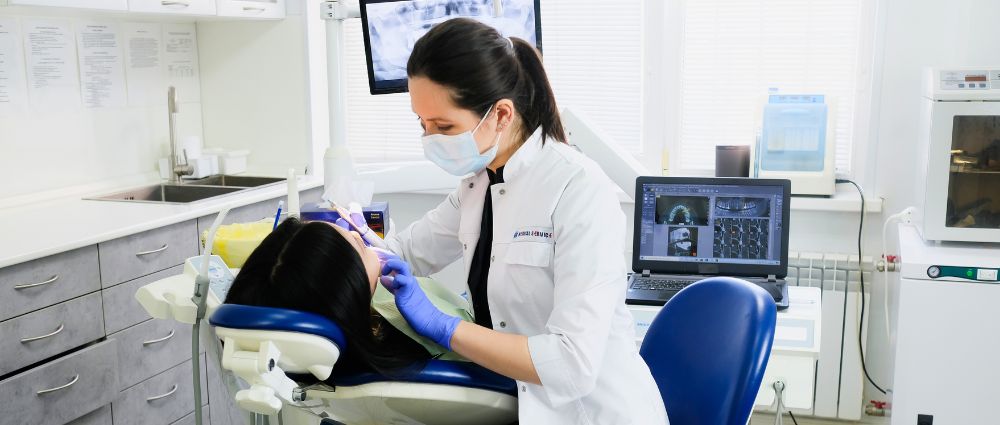Dental prostheses might be the solution you’re seeking if you’ve broken a tooth and want to restore your smile, or if you’d like to enhance the appearance and function of your damaged teeth. A smile is anyone’s calling card, and at Quality Dent, we understand the importance of showcasing a flawless smile. Fortunately, there are dental prostheses, essential tools in the field of dentistry that give back confidence and well-being to those who need them.
What are dental prostheses and what are they used for?
Dental prostheses are artificial structures designed to replace missing or damaged teeth. They not only enhance facial aesthetics but also restore the chewing function, allowing people to speak, eat, and smile with complete confidence. Moreover, they prevent the displacement of other teeth, maintaining the correct alignment and distribution in the mouth.
Furthermore, dental prostheses help to preserve the structure of the face and prevent oral issues that could arise due to missing teeth. For instance, when we lose one or more teeth, the jaw might lose its shape and firmness due to the lack of stimulation the teeth provided when chewing. This can lead to premature ageing of the face, giving it a sunken and less healthy appearance.
On the other hand, not having a suitable dental replacement can cause issues with the temporomandibular joint and imbalances in the bite, which could lead to pain and more severe complications over time. Dental prostheses serve as a preventive solution against these potential problems, providing support, balance, and most importantly, enhancing the individual’s quality of life. It’s an investment not only in aesthetics but also in health and well-being.
There are different types of dental prostheses
1. By shape
In the world of cosmetic and restorative dentistry, dental prostheses represent a revolution in regaining one’s smile and oral functionality. Crowns, for instance, stand out as one of the favourite options. These marvels, meticulously designed to replicate the shape and function of a damaged original tooth, are positioned directly over the existing tooth. They offer not just additional protection but a rejuvenated aesthetic.
In contrast, for wider gaps between teeth or a complete absence of them, bridges and veneers come into play. Bridges, as their name suggests, create a bridge over gaps, relying on adjacent teeth or implants for anchorage, ensuring a more fixed and stable solution. Veneers, on the other hand, have emerged as the go-to choice for those seeking a swift and efficient aesthetic fix. These thin layers, attached to the front surface of a tooth, instantly transform the appearance of one’s teeth, correcting imperfections and restoring confidence to every smile.
2. By material
Various material options are also available, each with its distinct advantages. Metal prostheses, for example, are widely popular for their strength and durability, thanks to the metal alloys used in their creation. However, their shiny and distinctive finish isn’t the preferred choice for those looking for a more discreet and aesthetically pleasing solution, especially in the more visible areas of the mouth.
In the realm of aesthetics, we find porcelain and zirconia. The former, made of dental ceramic, is renowned for its incredible replication of a natural tooth’s appearance. Zirconia, in turn, stands out as a middle-ground solution, blending the sturdiness of metal prostheses with the allure of ceramics. Lastly, composite presents itself as a cost-effective and versatile alternative, particularly useful for minor procedures or temporary solutions.
3. By fixation
Dental prostheses cater to the needs and preferences of each patient, offering tailor-made solutions. For example, they can be permanently integrated into the mouth, delivering a sensation closely resembling natural teeth thanks to their firm fixation. Yet, maintaining them in optimal conditions requires rigorous hygiene.
On the flip side, removable prostheses offer the advantage of flexibility, allowing users to take them out at their convenience. While their stability might not compare to fixed ones, they are a practical and affordable option for many. At the forefront of innovation, we have implant-supported prostheses. Directly affixed to the bone through implants, they offer a natural look. Although their placement involves surgery, the results in terms of comfort and aesthetics are well worth the procedure.
How are dental prostheses placed?
The process of placing a dental prosthesis varies based on the type and the patient’s needs. Typically, the procedure starts with a consultation to assess the patient’s oral condition. Impressions of the mouth are taken, and depending on the case, the space where the prosthesis will go is prepared, be it through tooth extraction or implant placement. Once the prosthesis is ready, it’s placed, ensuring a snug fit without causing discomfort to the patient. Adjustments might be needed later on to guarantee the comfort and functionality of the prosthesis.
Consult your dentist about dental prostheses
At Quality Dent, we understand how vital it is to regain the lost confidence and functionality due to missing or damaged teeth. Dental prostheses offer a solution for many, and at Quality Dent, we provide customised options for each patient.
Dental health and aesthetics are within your reach!


